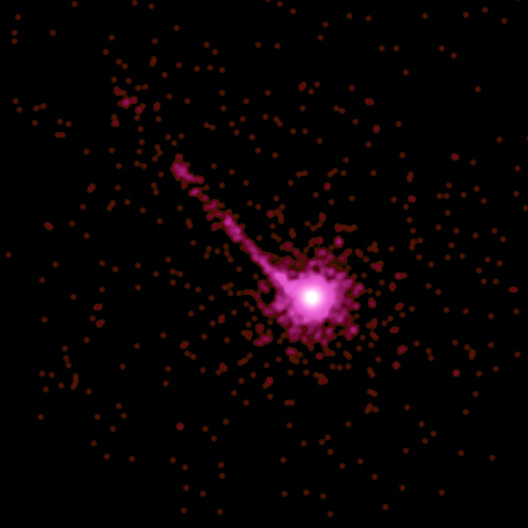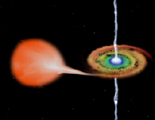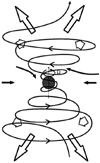An overview of the Chandra mission and goals, Chandra's namesake, top 10 facts.
Classroom activities, printable materials, interactive games & more.
Overview of X-ray Astronomy and X-ray sources: black holes to galaxy clusters.
All Chandra images released to the public listed by date & by category
Current Chandra press releases, status reports, interviews & biographies.
A collection of multimedia, illustrations & animations, a glossary, FAQ & more.
A collection of illustrations, animations and video.
Chandra discoveries in an audio/video format.
Disclaimer: This material is being kept online for historical purposes. Though accurate at the time of publication, it is no longer being updated. The page may contain broken links or outdated information, and parts may not function in current web browsers. Visit chandra.si.edu for current information.
Cosmic Jet Sets
by WKT
October 3, 2002 ::

Centaurus A |

PKS 1127-145 |
The popular picture of a black hole is that of a cosmic whirlpool that pulls everything within its reach into a bottomless pit of space from
which there is no escape. For most of the matter that drifts near a black hole, this is a fairly accurate picture. However, radio and X-ray telescopes have shown that there is more going on in the neighborhood of some black holes than a giant sucking sound.

Low Mass X-ray Binary |
Jets of high-energy particles resembling awesome waterspouts are commonly observed to be blasting away from the vicinity of black holes at near the speed of light. They are observed around stellar-sized black holes in our galaxy, and the supermassive black holes that lurk in the centers of galaxies. The stellar black hole jets extend for a light year or so, whereas the jets from supermassive black holes can reach across a million light years.
How is it possible that a black hole, the ultimate sinkhole, can expel matter at such high speeds? The answer is that enormous electromagnetic forces shot it away before it got beyond the black hole's event horizon. These powerful forces are generated as magnetized, hot gas swirls toward the black hole creating extreme voltages which accelerate particles away from the disk in opposite directions.

Schematic of a Jet
(D. Meier et al, Science) |
One puzzle is how the jets can maintain their narrow trajectory over a
million light years. The best bet at this point is that a tightly coiled
magnetic field is spun out with the particles. One team of scientists
exploring this line of reasoning has concluded that black holes may be
the primary source of magnetic energy in the universe. This could be
highly significant because, as is known from observations of solar
flares, magnetic energy can readily change into other forms of energy.
These ideas about the nature of jets need to be tested - a difficult
proposition for objects millions of light years away and processes that
take tens of thousands to millions of years to unfold. That is why the
discovery and subsequent study of the life cycle of jets from the black
hole system XTE J1550 in our galaxy has stimulated such excitement among
astronomers.

XTE J1550-564 |
XTE J1550 is only 17,000 light years away from Earth and the entire
process - from the expulsion of the jets, to the slowing down and
eventual fading of one of the jets - took only four years. Similar
binary star systems with jets exist in our galaxy. Careful study of
these black hole jet sets over the next few years may unlock more
secrets of the enigmatic black holes, which turn out to be givers as
well as takers in the cosmic scheme of things.
Disclaimer: This material is being kept online for historical purposes. Though accurate at the time of publication, it is no longer being updated. The page may contain broken links or outdated information, and parts may not function in current web browsers. Visit chandra.si.edu for current information.









